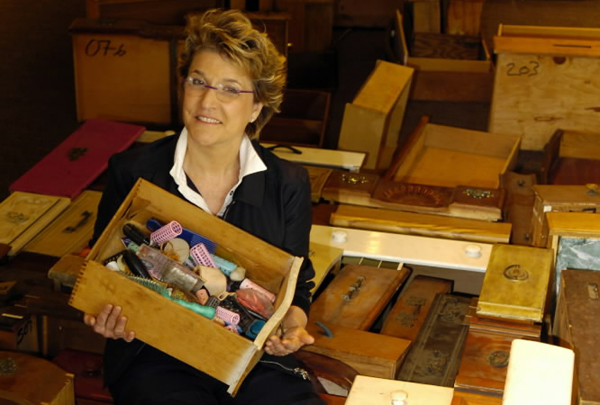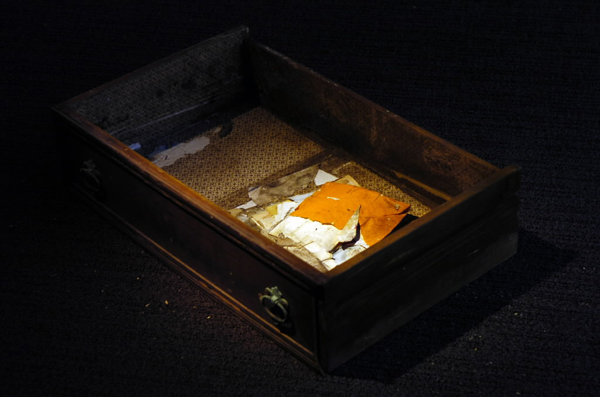
|
Home About Exhibitions Drawers & Stories Press Blog Contact Supporters |

The Advocate (Baton Rouge) - July 8, 2007
Dresser drawers form installation, sympol of hope following Katrina By CYNTHIA V. CAMPBELL Artist Jana Napoli sits with some of the 700 dresser drawers she collected from front-yard trash piles in New Orleans after Hurricane Katrina. Drawers, all sizes, shades and styles - Federal, Louis IV, Art Deco - speak untold stories to viewers of Floodwall. The freestanding art installation is a tribute to New Orleans in the aftermath of Hurricane Katrina. Arranged in a wall 8 by 96 feet, the exhibit is constructed of 350 dresser drawers recovered from the flood debris, each piece looking as it did when it was tossed into a yard or street following the flood. Floodwall, created by New Orleans artist Jana Napoli in collaboration with Rondell Crier and Whirlwind Creative, opens Friday, July 13, at the Louisiana State Museum-Baton Rouge. Both Napoli and Crier have been recognized for their years of service with Young Aspirations/Young Artists, Inc., a New Orleans youth arts program which encourages young people to develop their skills and become responsible adults. A smaller version of Floodwall was displayed in New York City at the World Financial Center as an installation on the Liberty Street Pedestrian Bridge overlooking Ground Zero between Jan. 4-Feb. 9. It was visited by almost a million viewers, and received the attention of national media, including The New York Times. The completed exhibition will show here in the city that took in artist Napoli and her mother, Ana Napoli (now age 92 and living in Birmingham) following the flood. When Katrina hit Aug. 29, 2005, Napoli, who has a studio on Baronne Street, was working on an art installation about rubber bands that her mother had saved. After the flood she and her mother managed to escape to the garage apartment of relatives, Mr. and Mrs. Dean Napoli, in Baton Rouge. Returning to New Orleans, the artist looked for drawers for her rubber band project. "The first drawers I picked up were the top drawers. They mostly had pencils, paper and notes in them," said Napoli, a small woman with a soft voice. She kept searching, adding more and more. Napoli said the silence was dreadful. "It was like Pompeii. It was as if everything in life had gone 'click.' There was no editing." "I thought they could become a microcosm of what life was like in August 2005. Life just stopped right there." 
Napoli, who grew up in the Lakeview area of New Orleans, searched for drawers in every neighborhood of the city. "It was so hot. I couldn't stand it out in the streets. The dust from the trucks just covered you. The maggot flies covered you every time you went into the piles." While gathering more than 700 drawers, Napoli noted the address on each drawer. If there was anything in the drawer, she dumped it. In some, items were stuck, and these she left alone. Keeping them became a problem. "The drawers were everywhere, in my mother's apartment, in the carport in front of my relatives' garage," said Napoli. Finally David Oreck gave her warehouse space in a building in downtown New Orleans. "That's where they've been for the last year and a half," said Napoli. "In 2005, Aimee St. Amant and Sam Rykels came to my studio in New Orleans and looked at the drawers. They said 'this' should be in the Louisiana State Museum. They were the first people to see it," she said. Napoli said that before funds could be raised in Louisiana to pull the exhibit together, New York came up with the money. Major funding came from the Lower Manhattan Cultural Council and the World Financial Center. David Lackey, owner of Whirlwind Creative, designed the installation, so it would fit in Liberty Bridge. The exhibition in Baton Rouge will be the first time that the drawers will be shown as a complete work. As viewers walk along Floodwall, they will hear audio commentaries from Katrina victims who once owned the drawers. Each voice tells a tale not to be forgotten. Working with Napoli, oral historian Tatiana Clay is seeking interviews from the drawers' original owners. To date, she has recorded the voices of 16 people. But speaking silently of Katrina's devastation, the drawers themselves bring a flood of memories to viewers. Small items, such as a woman's hair rollers or a tiny notebook stuck forever against water-stained wood, recall both the desperation and bravery exhibited during and after the flood. "For me, it's a memorial," said Napoli, who still handles each drawer with reverence. "I'm reflecting (in the art installation) a city in sorrow. "It's also about what our city should look like. Every neighborhood, every person connected to the person who lives next to them. It's a microcosm of the community I hoped would be reborn in New Orleans." Napoli said Floodwall, as displayed at the Louisiana State Museum, honors all the cities of Louisiana, "especially Baton Rouge for its incredible generosity following Katrina." She also sees the installation as a means to change the image of Louisiana by giving a positive vision of the resolve and perseverance of its citizens. Floodwall will remain at the Louisiana State Museum through Oct. 13. Following its show in Baton Rouge, Napoli hopes Floodwall will tour other cities around Louisiana and the nation. Already, she has been contacted about showing the installation in Germany during 2008. The museum, 660 N. Fourth St., is open 9 a.m.-5 p.m. Tuesday-Saturday, and noon-5-p.m. Sunday. Admission is $6, adults; $5, seniors, students and active military. Free to children under age 12. Call (225) 342-5428. Reproduced with permission of the copyright owner. Further reproduction or distribution is prohibited without permission.
|
||